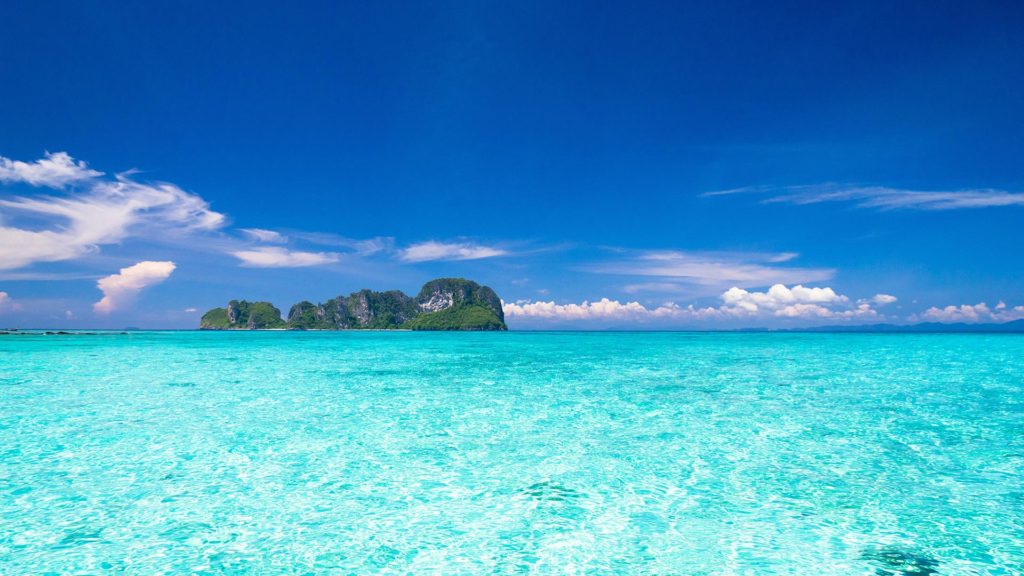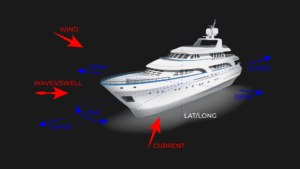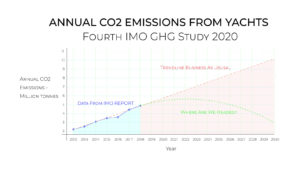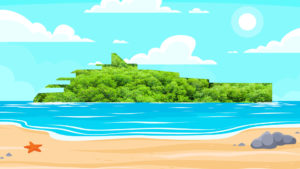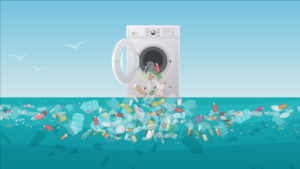Although the primary environmental concern challenging our industry is C02 and other emissions generated from burning fossil fuels, there are other vectors such as sewage and grey water that can also have an impact.
Whilst on the larger yachts the new treatments plants take care of both, producing effluent that can be clean enough to use as wash down water, smaller and/or older yachts may not be so well equipped, or have inadequate black/grey holding tanks. Grey water is often simply discharged overboard.
For those of us who have had the ‘pleasure’ of sticking their head into a grey water tank, we are only too aware of the odious and putrid soup that is contained within, in fact, I suggest many crew would rather inspect a sewage tank than a grey water tank such is the assault on the senses. And, given these sensory observations, and the impact grey water can have on tank coatings, why is grey water treated essentially as a harmless liquid?
Whilst the discharge of sewage (black water) is mostly regulated under the International Convention for the Prevention of Pollution from Ships (MARPOL) Annex IV and other national legislation such as United States Environmental Protection Agency (EPA) Clean Water Act (CWA) grey water from ships and yachts is discharged untreated directly into the sea. On yachts, this is very often in close proximity to the coast, beaches, ports and marinas, where there are swimmers or other recreational water users and where it has the potential for the greatest impact on the marine ecosystem.
So what is grey water?
*If using mobile phone, swipe or rotate screen to see the full table.
| Source | Grey Water Definition |
|---|---|
| MARPOL 73/78 | Annex V Reg 1 Definitions 4. Domestic wastes means all types of wastes not covered by other Annexes that are generated in the accommodation spaces on board the ship. Domestic wastes does not include grey water. |
| RESOLUTION MEPC.219(63) | 1.6 Definitions 1.6.1 Dishwater means the residue from the manual or automatic washing of dishes and cooking utensils which have been pre-cleaned to the extent that any food particles adhering to them would not normally interfere with the operation of automatic dishwashers. 1.6.2 Grey water means drainage from dishwater, shower, laundry, bath and washbasin drains. It does not include drainage from toilets, urinals, hospitals, and animal spaces, as defined in regulation 1.3 of MARPOL Annex IV (sewage), and it does not include drainage from cargo spaces. Grey water is not considered garbage in the context of Annex V. *Note: if in-sink macerators drain into grey water tanks, then the contents and discharge of that tank will need to comply with Annex V. |
| Clean Water Act, 33 U.S.C. 312(a)(11) | Galley bath and shower |
| Coast Guard regulations, 33 CFR 151.05 | Drainage from dishwasher, shower, laundry, bath, and washbasin drains and does not include drainage from toilets, urinals, hospitals and cargo spaces. |
So, whilst grey water is well defined, what is less well understood is that untreated grey water contains many undesirable pathogens, organic matter, chemicals and micro plastics (the microfibres that are shed during washing of man-made fabrics) often at levels that can be higher than domestic effluent from sewage treatment plants, and can have an impact on human health and the marine ecosystem.
One of the largest studies on grey water was done by the EPA following a petition in 2000 from Bluewater Network who represented 53 environmental organisations who wanted the EPA to take regulatory action on cruise ship pollution. The report – Draft Cruise Ship Discharge Assessment Report (EPA842-R-07-005) – was published in 2007 and covered sewage, oily bilge water, solid waste, hazardous waste and grey water. And, whilst there are significantly more crew/passengers on cruise ships and waste volumes greater, the sources and treatment are very similar to the superyacht industry.
From that study they list common sources and characteristics of grey water in the table below.
| Water Source | Characteristics |
|---|---|
| Automatic Clothes Washer | bleach, foam, high pH, hot water, nitrate, oil and grease, oxygen demand, phosphate, salinity, soaps, sodium, suspended solids, turbidity Note: recent studies also suggest micro plastics from man-made fibres are also contained with the waste water. |
| Automatic Dish Washer | bacteria, foam, food particles, high pH, hot water, odor, oil and grease, organic matter, oxygen demand, salinity, soaps, suspended solids, turbidity |
| Sinks, including kitchen | bacteria, food particles, hot water, odor, oil and grease, organic matter, oxygen demand, soaps, suspended solids, turbidity Note: if food waste from in-sink macerators is draining into grey water tanks this changes the grey water to food waste and therefore discharge must comply with MARPOL V. |
| Bathtub and Shower | bacteria, hair, hot water, odor, oil and grease, oxygen demand, soaps, suspended solids, turbidity |
Source: ASCI 2001
Of course, the quantity and quality of grey water varies considerably depending on many factors, such as the number of crew and passengers, the various types of detergents and cleaning products used, personal grooming and hygiene products used by the crew and passengers, and various filters and fat traps if installed.
The EPA study, combined with findings from a previous study by the Alaskan Department of Environmental Conservation – Alaska Cruise Ship Initiative in 2001, found a range of readings of various analytes. A sample of which are found below.
| Type | Units | Av. Concentration | Untreated Domestic Water |
|---|---|---|---|
| Pathogens | |||
| E.Coli | MPN/100mL | 292,000 | |
| Enterococci | MPN/100mL | 8,920 | |
| Fecal Coliform | MPN/100mL | 2,950,000 | 10,000 – 100,000 |
| Other Pollutants | |||
| Biological Oxygen Demand (BOD 5 day) | mg/L | 1,140 | 110 – 400 |
| Chemical Oxygen Demand | mg/L | 1,890 | 250 – 1,000 |
| Alkalinity | mg/L | 53.8 | |
| pH | 66.9% between 6.0 and 9.0 | Between 6.0 and 9.0 | |
| Sulfate | mg/L | 49.9 | |
| Totals Dissolved Solids (TDS) | mg/L | 578 | |
| Total Suspended Solids (TSS) | mg/L | 704 | 100 – 350 |
| Turbidity | NTU | 224 | |
| Nutrients | |||
| Ammonia – Nitrogen | mg-N/L | 2.13 | 12 -50 |
| Nitrate/Nitrite | mg/L | 0.0872 | 0 |
| Total Kjeldahl Nitrogen | mg/L | 10.1 | 20 – 85 |
| Total Phosphorous | mg/L | 10.1 | 4 -15 |
*MPN – most probable number
Pathogens
Untreated grey water contains many pathogens and, in addition to those listed above, can also include, Salmonella, shigella, hepatitis A and E, and gastro intestinal viruses (national Research Council, 1993). Pathogens can pose danger to human health by contact or ingestion of contaminated water, or by consuming shell fish which feed by filtering water.
The 1986 EPA Quality Criteria for Water, commonly known as the ‘Gold Book’, references pathogen indicators and has defined water quality standards based on two activities of import to yachting: marine water bathing and, shellfish harvesting.
From the samples of untreated grey water analysed in the study, the average fecal coliform contamination exceeded the standard of 43 MPN/100mL for shellfish harvesting and, the average enterococci contamination exceeded the standard of 35 MPN/100mL for marine water bathing.
Chlorine
Although not a major indicator in this study, chlorine is used on yachts in a variety of applications including sanitising fresh water tanks, the discharge of which is generally pumped overboard, often via the grey water tanks, so levels must be carefully controlled so they do not exceed recommended limits.
Studies have found that chronic affects to the marine biota such as poor reproduction and health can be observed at concentrations above 230mg/L with acute effects, severe illness or death, at concentrations exceeding 860 mg/L.
Oxygen Demand
Organic matter from the grey water acts as food for water borne bacteria. The more food available, the greater the number of bacteria decomposing the waste and using oxygen in the process. Nitrates and phosphorous also contribute to high oxygen demand by providing nutrients for plants and algae to grow quickly, contributing to organic waste when plants die and decompose.
Reductions in oxygen level can be harmful to aquatic species and can, in extreme cases, create ‘dead zones’ where no fish or other organisms can live.
Dissolved Solids
Suspended solids can affect the clarity of the water and in turn adversely affect the photosynthetic activity of marine biome.
Micro Plastics
This is a more recent and topical concern relating to plastics entering the food chain, consumption by humans, and the longer term environmental and health impacts.
A number of studies have shown that during machine washing of man-made clothing significant numbers of tiny fibres are released into the waste water; and, in the case of yachts, into the grey water tank and eventually into the sea.
One such study is ‘The release of microplastic micro fibres from domestic washing machines: Effects of fabric type and washing conditions’ (Elsevier: Imogen E. Napper, Richard C. Thompson).
This study examined the release of textile fibres during machine washing of clothes from three commonly used fabrics; polyester, polyester-cotton mix and acrylic. The results showed that laundering 6kg of synthetic material could release between 137,951 – 728,789 fibres per wash, ranging in size between 20 𝜇m and <5mm. Given the load on most laundries and, composition of the fabrics washed, one can see the potential for a significant number micro plastics being discharged into the sea on a daily basis.
Dilution
It is important to note that when grey water is discharged into the surrounding sea it mixes with the sea water and dilution takes place. This effect can be affected by factors such as discharge rate, salinity, water temperature, wind, currents and, of course, a yachts movement.
The Alaska Department of Environmental Conservation (ADEC) concluded that dilution factor would range from approx. 5 to 60 and occur between 1 and 7 meters from the ship (ADEC, 2004). The EPA report suggests that the initial dilution estimated by ACSI and ADEC for a vessel at rest would not likely be great enough for untreated grey water to meet the ‘Gold Book’ standards for fecal coliform and enterococci
From tests conducted by the EPA, it was shown that the dilution effect, due to the movement of a vessel and the mixing by their propellers, for a ship underway between 9.1 and 17.4 knots was a factor of between 200,000:1 and 640,000:1 immediately behind the vessel and, based on those results all ‘Gold Book’ standards for water quality, apart from fecal coliform, would be met.
From this it can be seen there are significant benefits in only discharging when underway and away from the near shore.
Apart from yachts that have advanced waste treatment systems that treat both grey and blackwater compliant with MARPOL IV 9.1.1 and the guidelines in MEPC.227(64) most yachts will be discharging untreated grey water from their holding tanks, often with food waste contrary to MARPOL V, whilst static, directly into the sea. The effect of this can be observed in busy marinas and crowded anchorages on windless days when there is little water movement or seabed disturbance and the water takes on a milky and/or scummy appearance – the difference in water clarity around Cala de Volpe in and out of season is quite striking.
Furthermore, the grey water has the potential for human health risk – depending on contamination levels – especially for those engaging in activities such as swimming, jet ski, wake-boarding, or any other activity where they may ingest seawater or have contact via an exposed scratch or wound. There are also short and long terms considerations related to the marine ecosystem such as algae blooms, bacteria in shellfish, and the introduction of micro plastics into the food chain.
Whilst the issue surrounding grey water applies to commercial shipping as well, due to their sailing and trading patterns they tend to have little impact on inshore waters – as can be seen from dilution effect underway. For cruise ships, if they do not have suitable onboard treatment of grey water, the Cruise Lines International Association (CLIA) members voluntarily agreed to limit the discharge of untreated grey water to when they are underway at not less than 6 knots and at least 4 nm from the nearest land and not to discharge grey water when in port.
What can we do?
I outline some of the steps could be taken to reduce the impact of grey water discharges.
- As per CLIA, no grey water discharge closer than 4nm from nearest land, underway at not less than 6 knots
- No discharge of grey water in port if facilities available – marinas have work to do here?
- Where available, discharge grey water to suitable reception facilities e.g. barge or ashore
- On new builds, increase size of holding tanks to more practical sizes based on ‘practical’ use of yachts, so discharge can be better managed – including smaller yachts
- Install filters to remove micro fibres from washing machines
- Use ‘environmentally friendly’ cleaning and personal hygiene products – not just ‘ECO or Green’ labeled as these are often-abused and misleading descriptions – carefully scrutinise such claims and check if they have been independently assessed and verified
- On new builds specify and install only black/grey water treatment plants
- On refits, consider updating your treatment plant and include grey water
- Consider dosing grey water with additives that reduce pathogens and/or organic matter
- Avoid using in-sink macerators if the pulp discharges directly into grey water tanks – instead, bag, store and dispose as per MARPOL V
- Installation of fat traps
Some of the above does not require major expense, just a change in operational procedures and, of course, education costs nothing.
The quality of our oceans, and its health are fundamental to yachting – it is the ‘playground’ from which we experience so much pleasure. With our intimate connection to the to the sea we have a responsibility to minimise our environmental impact, protect the long term health of our oceans, and to ensure that future generations get to experience the same pristine seas and diverse marine life that we have all enjoyed.

